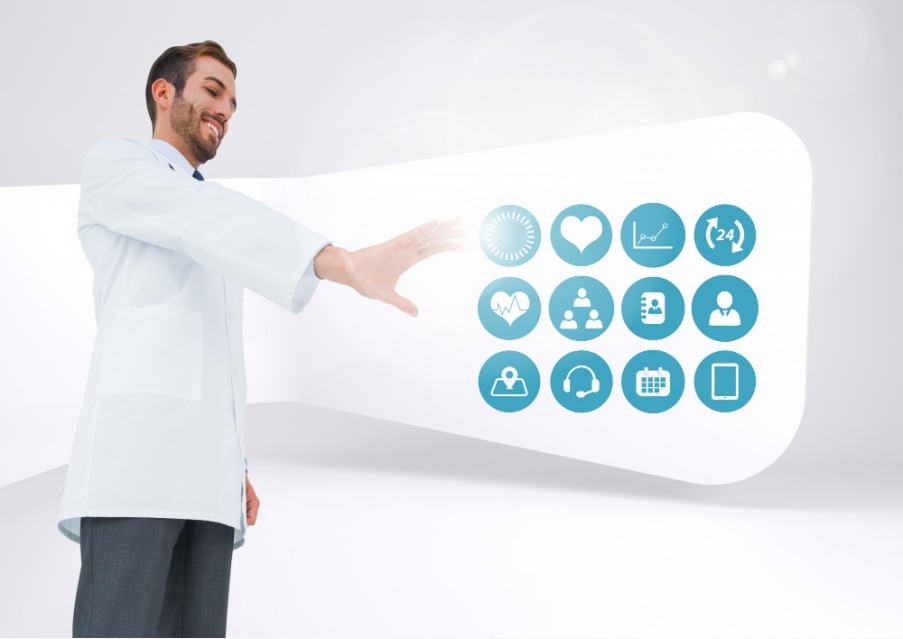
Healing Hands in a Digital World: The Modern Physician’s Toolkit
Introduction
In a world of rapidly advancing technology, the physician’s toolkit has been forever altered. No longer is it enough to rely solely on the healing power of the human hand; instead, physicians must now learn to wield digital tools to better care for their patients. By leveraging the latest technologies, a telemedicine physician can access vast amounts of data, provide more precise diagnoses, and monitor patient progress more efficiently.
In this blog post, we’ll explore how digital technology is transforming the role of the physician in our modern world.
The Digital Transformation of Medicine
Medicine is undergoing a monumental shift as digital technology continues to revolutionize the healthcare industry. The traditional image of the physician as a healer with only their hands and intuition is being replaced by a new paradigm that embraces the power of data, artificial intelligence, and interconnectedness.
With the advent of electronic health records (EHRs), physicians can access comprehensive patient information instantly, leading to more accurate and efficient diagnoses. The integration of telemedicine allows doctors to provide virtual consultations, reaching patients who may not have access to healthcare facilities or who need urgent care. Remote monitoring technologies enable Physician to track patient health in real-time, ensuring timely interventions and improved outcomes.
Artificial intelligence (AI) has emerged as a powerful tool for diagnosing diseases and predicting patient outcomes. Machine learning algorithms analyze vast amounts of medical data to identify patterns, enabling physicians to make more informed decisions.
Wearable devices and personal health tracking devices have become commonplace, empowering patients to monitor their own health and enabling physicians to gather more data on their patients’ daily activities and vital signs.
This digital transformation offers unprecedented opportunities to improve patient care, streamline workflows, and enhance medical outcomes. However, it also brings new challenges, such as ensuring data security and privacy, addressing ethical concerns, and training healthcare professionals to effectively utilize these technologies.
As the digital transformation of medicine continues to unfold, the role of the physician will continue to evolve, embracing technology to deliver more precise, efficient, and personalized care.
Benefits of Technology in Healthcare
Technology has revolutionized the healthcare industry, bringing with it numerous benefits for both physicians and patients. One of the key advantages is improved access to healthcare services. Telemedicine, for example, allows patients to receive medical advice and consultations remotely, eliminating the need for physical appointments and reducing travel time and costs.
Digital technology also enables more efficient and accurate diagnoses. Electronic health records (EHRs) provide physicians with instant access to comprehensive patient information, facilitating more informed decision-making and reducing the risk of errors. Artificial intelligence (AI) algorithms can analyze large amounts of medical data and identify patterns that may not be obvious to human doctors, leading to more precise and timely diagnoses.
In addition, technology improves patient outcomes by enabling remote monitoring of vital signs and health conditions. Wearable devices and personal health tracking devices allow patients to actively participate in their own healthcare by continuously monitoring their health status. Physicians can access this data in real-time, enabling early detection of any concerning trends or changes, and intervening promptly to prevent worsening conditions.
Overall, technology in healthcare has the potential to greatly improve patient access, diagnosis accuracy, and health outcomes. By embracing digital tools, physicians can enhance the care they provide to their patients and improve the overall quality of healthcare delivery.
Telemedicine and Remote Monitoring
Telemedicine and remote monitoring are two powerful tools that have transformed the way physicians deliver healthcare. With the advancements in digital technology, doctors can now connect with patients remotely, providing medical advice and consultations without the need for physical appointments. This is particularly beneficial for individuals living in rural or underserved areas who may not have easy access to healthcare facilities. Telemedicine eliminates the barriers of distance and allows patients to receive timely care, reducing the need for unnecessary travel and associated costs.
Remote monitoring technologies have also revolutionized patient care. Wearable devices and personal health tracking devices enable individuals to monitor their own health in real-time. Patients can track vital signs, daily activities, and even chronic conditions from the comfort of their homes. Physicians can access this data and intervene promptly if any concerning trends or changes are detected. This proactive approach to healthcare empowers patients to take control of their well-being while enabling physicians to provide personalized and targeted interventions.
Overall, telemedicine and remote monitoring enhance access to healthcare, improve patient outcomes, and increase efficiency in the healthcare system. These technologies bridge the gap between patients and physicians, allowing for better care coordination and ensuring that individuals receive the support they need, regardless of their location.
Artificial Intelligence in Diagnostics
Artificial intelligence (AI) has revolutionized the field of diagnostics, offering unprecedented capabilities to physicians. With the power of AI algorithms, vast amounts of medical data can be analyzed quickly and accurately, leading to more precise and timely diagnoses.
AI systems are capable of learning from millions of medical images, such as X-rays and MRI scans, to identify patterns and anomalies that may be missed by human doctors. These algorithms can detect early signs of diseases, enabling physicians to intervene before they progress to advanced stages.
In addition, AI can assist in the interpretation of complex genetic and molecular data, providing valuable insights into a patient’s risk for certain diseases or response to specific treatments.
Wearables and Personal Health Tracking Devices
Wearables and personal health tracking devices have emerged as a significant aspect of the digital transformation in healthcare. These devices, ranging from fitness trackers to smartwatches, have become increasingly popular and are revolutionizing how individuals monitor and manage their health on a daily basis.
By wearing these devices, patients can track various health parameters such as heart rate, sleep patterns, physical activity, and even stress levels. This continuous monitoring provides valuable data to both patients and physicians, allowing for a more comprehensive understanding of an individual’s health status.
For patients, wearables serve as a constant reminder to stay active and make healthier lifestyle choices. They can set goals, track progress, and receive personalized recommendations based on the data collected by these devices. This promotes patient engagement and empowers individuals to take control of their own well-being.
From a physician’s perspective, wearables provide a wealth of information that was previously inaccessible during routine office visits. Physicians can gain insights into their patients’ daily activities, identify trends, and monitor progress over time. This data can be particularly useful in managing chronic conditions, identifying potential health risks, and personalizing treatment plans.
Overall, wearables and personal health tracking devices are changing the way individuals approach their health and enabling physicians to make more informed decisions. As technology continues to advance, these devices will only become more sophisticated, further enhancing the role of wearables in healthcare.
Electronic Health Records and Patient Portals
Electronic Health Records (EHRs) and patient portals have revolutionized the way physicians access and manage patient information. EHRs are digital versions of patients’ medical records, containing comprehensive information about their medical history, medications, allergies, test results, and more. These records are accessible to authorized healthcare providers, ensuring that important information is readily available at the point of care.
Patient portals are secure online platforms that allow patients to access their own health records, communicate with their healthcare providers, schedule appointments, and view test results. This empowers patients to take an active role in their healthcare and stay informed about their own medical history.
The implementation of EHRs and patient portals has numerous benefits for both physicians and patients. For physicians, these digital platforms streamline workflow, eliminate the need for paper-based records, and reduce the risk of errors due to illegible handwriting or lost documents. They also enable better coordination of care, as multiple providers can access and update the same patient record in real-time.
For patients, EHRs and patient portals provide convenience and accessibility. They can easily access their medical records, review their health information, and communicate with their healthcare providers from the comfort of their own homes. This fosters a sense of engagement and empowers patients to actively participate in their own healthcare decisions.
Overall, electronic health records and patient portals have transformed the physician’s ability to access and manage patient information, improving efficiency, accuracy, and patient engagement in the healthcare process.
Patient Engagement and Education through Digital Platforms
Digital platforms have transformed the way physicians engage with patients and provide education on healthcare topics. Patient engagement is crucial for successful healthcare outcomes, and digital platforms play a significant role in facilitating this engagement. Through online portals and mobile applications, patients have easy access to educational resources, such as articles, videos, and interactive tools, that provide information about their conditions, treatments, and overall wellness. These resources empower patients to take an active role in managing their health and make informed decisions about their care.
Digital platforms also enable physicians to communicate with patients in a more timely and efficient manner. Through secure messaging systems, patients can ask questions, request prescription refills, or share updates on their health, eliminating the need for in-person or phone consultations for routine matters. This improves accessibility to care and allows physicians to provide timely guidance and support.
Challenges to Implementation of Digital Health Solutions
As with any technological advancement, the implementation of digital health solutions in the healthcare industry comes with its fair share of challenges. One major obstacle is the issue of data security and privacy. With the vast amounts of personal health information being stored and transmitted electronically, there is an increased risk of data breaches and unauthorized access. Healthcare providers and technology companies must invest in robust security measures and adhere to strict privacy regulations to ensure patient information remains protected.
Many physicians may be hesitant to adopt new digital tools and technologies due to concerns about workflow disruption, lack of training, and skepticism about their effectiveness. Additionally, integrating these technologies into existing healthcare infrastructure can be a complex and time-consuming process, requiring significant financial investment.
Furthermore, there are ethical considerations surrounding the use of digital health solutions. For example, the use of artificial intelligence in diagnostics raises questions about the role of the physician and the potential for AI algorithms to make decisions that may not align with the patient’s values or preferences. Balancing the benefits of technology with the need for human involvement and empathy in healthcare is an ongoing ethical debate.
Ethical Considerations for Physicians in a Digital World
As technology continues to reshape the field of medicine, physicians are faced with a host of ethical considerations in this digital world. One of the main concerns is the potential for technology to dehumanize the patient-doctor relationship. As more healthcare services are provided remotely through telemedicine, the personal connection between physicians and their patients may be compromised. It is important for physicians to find a balance between utilizing technology for efficiency and maintaining a compassionate and empathetic approach to patient care.
With the increasing use of electronic health records and wearable devices, vast amounts of personal health information are being collected and stored. Physician must ensure that patient data is handled with the utmost care, protecting patient privacy and confidentiality. Additionally, the use of artificial intelligence in healthcare raises concerns about bias, accountability, and transparency. Physicians must be vigilant in ensuring that AI algorithms are used ethically and do not perpetuate discrimination or harm to patients.
Furthermore, the digital divide poses ethical challenges. While technology has the potential to improve access to healthcare services, it may also exacerbate existing inequalities. Not all patients have equal access to digital tools or the ability to navigate online platforms. Physicians must be mindful of these disparities and strive to provide equitable care to all patients, regardless of their technological literacy or access.







